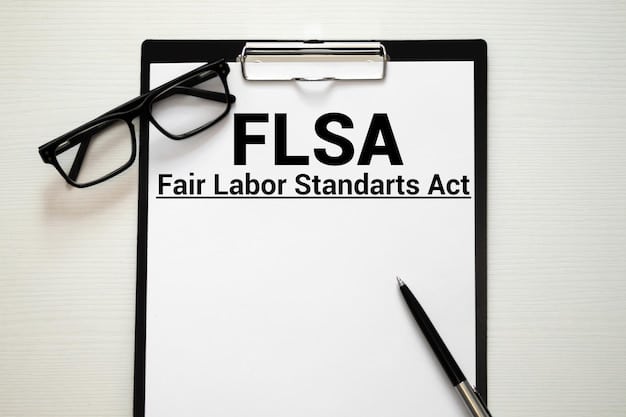Understanding New Unemployment Benefits Rules: Eligibility & Duration

Navigating the new rules for unemployment benefits in the U.S. requires understanding updated eligibility criteria, duration limits, and application processes to ensure individuals receive the support they need during periods of unemployment.
The landscape of new rules for unemployment benefits: what you need to know about eligibility and duration is constantly evolving, responding to economic shifts and policy changes. Staying informed about these changes is crucial for anyone who might face unemployment.
Understanding Eligibility Criteria for Unemployment Benefits
Eligibility for unemployment benefits isn’t universal. It hinges on factors like your previous employment history, the reason for your job loss, and your ongoing efforts to find new work. States have their own specific rules, so it’s important to familiarize yourself with those where you last worked.
Work History and Earnings
Generally, you’ll need to demonstrate a certain amount of work history and earnings within a “base period,” typically the first four of the last five completed calendar quarters before you file your claim. Some states offer alternative base periods if you don’t qualify under the standard one.
Reason for Unemployment
The reason you’re out of work matters. Typically, you must be unemployed through no fault of your own. This usually means you were laid off or your position was eliminated. Quitting your job without good cause or being fired for misconduct can disqualify you from receiving benefits. However, each case is evaluated individually, and there are exceptions and appeals processes.
- Minimum earnings requirements: Know the minimum wage you must have earned to qualify.
- Qualifying job separation: Understand what circumstances qualify you for benefits.
- Active job search: Document all job search activities to prove eligibility.

To sum up, your eligibility depends on your work history, the reason for your unemployment, and your adherence to state-specific requirements. Thoroughly understanding these criteria will help you navigate the application process more effectively.
Duration of Unemployment Benefits: What to Expect
The duration of unemployment benefits isn’t indefinite. It’s designed to provide temporary support while you seek new employment. The standard duration varies by state, but it’s typically capped at a certain number of weeks.
Standard Benefit Duration
Most states offer a maximum of 26 weeks of regular unemployment benefits. However, this can fluctuate based on state laws and economic conditions.
Extended Benefits During High Unemployment
During periods of high unemployment, extended benefits (EB) may become available. These extend the duration of benefits beyond the standard 26 weeks, providing additional support when job opportunities are scarce. The trigger for EB varies by state and is usually based on the state’s unemployment rate.
- State-specific duration: Check your state’s website for precise duration information.
- Extended benefits triggers: Stay informed about economic conditions that may extend benefits.
- Impact of part-time work: Understand how part-time income will affect your allocation.
In conclusion, the duration of unemployment benefits depends on state laws and economic conditions. Be aware of the standard duration in your state and whether extended benefits are available during periods of high unemployment. Managing your job search within the allotted time is essential for financial stability.
Navigating the Application Process
Applying for unemployment benefits can seem daunting, but understanding the steps involved can make the process smoother. Each state administers its unemployment insurance program, so the application process can vary.
Gathering Necessary Documentation
Before you start your application, gather all necessary documentation. This typically includes your Social Security number, driver’s license or other valid ID, employment history for the past 18 months, and information about any severance pay or other income you’re receiving.
Online Application vs. In-Person Assistance
Most states allow you to apply for unemployment benefits online. This is often the quickest and most convenient method. However, some states may also offer in-person assistance or require certain steps to be completed in person. Check your state’s unemployment website for details.

Applying for unemployment benefits involves gathering necessary documentation and choosing between online application or in-person assistance. Following the specific procedures outlined by your state’s unemployment website can streamline the process and ensure you receive benefits in a timely manner.
Understanding Waiting Periods and Payment Delays
After applying for unemployment benefits, it’s common to experience a waiting period before your first payment arrives. Understanding these waiting periods and potential payment delays can help you plan your finances accordingly.
Common Causes for Delays
Several factors can cause delays in receiving unemployment benefits. These include verification of your employment history, investigation of the reason for your unemployment, and processing backlogs. Be patient and responsive to any requests for additional information from your state’s unemployment agency.
Strategies to Expedite Payments
While you can’t eliminate waiting periods entirely, there are steps you can take to expedite your payments. Ensure your application is complete and accurate, respond promptly to any requests for information, and check the status of your claim regularly through your state’s unemployment website.
- Initial waiting week: Be prepared for the standard initial wait.
- Verification processes: Understand why verification may take time.
- Appeal options for denials: Know your rights if you are denied.
In summary, waiting periods and payment delays are common in the unemployment benefits process. Understanding the causes of these delays and taking steps to expedite payments can help you manage your finances during this transition period.
Impact of Part-Time Work and Self-Employment
Many individuals find themselves taking part-time work or exploring self-employment opportunities while receiving unemployment benefits. Understanding how these activities impact your benefits is essential.
Reporting Part-Time Earnings
Most states require you to report any earnings from part-time work while receiving unemployment benefits. The amount your benefits are reduced typically depends on how much you earn. Some states have specific formulas or disregard amounts that allow you to earn a certain amount without affecting your benefits.
Self-Employment and Benefit Eligibility
Starting your own business or engaging in self-employment while receiving unemployment benefits can be tricky. Some states have programs that allow you to pursue self-employment while still receiving benefits, while others may consider you ineligible if you’re actively engaged in operating a business.
To conclude, part-time work and self-employment can impact your unemployment benefits. Reporting earnings accurately and understanding your state’s rules regarding self-employment are crucial for maintaining eligibility and avoiding overpayment issues.
Staying Informed About Policy Changes
Unemployment benefit policies are not static. They can change due to economic conditions, legislative actions, and administrative updates. Staying informed about these changes is essential for understanding your rights and responsibilities.
Following Legislative Updates
Keep an eye on legislative updates at both the state and federal levels. These updates can affect eligibility criteria, benefit amounts, and duration of benefits. Sign up for email alerts from your state’s unemployment agency and follow relevant news sources.
Checking Official Government Resources
Reliable information about unemployment benefits can be found on official government websites. These websites provide detailed explanations of current policies, eligibility requirements, and application procedures. Be wary of unofficial sources or third-party websites that may contain outdated or inaccurate information.
- Subscribe to updates: Sign up for news and resources proactively
- Regular Reassessment: Keep reassessing your situation.
- Professional Consultation: Seek guidance when faced with policy questions.
Staying informed about unemployment benefit policy changes requires following legislative updates and checking official government resources. Keeping abreast of these changes can help you navigate the unemployment system more effectively and ensure you receive the benefits you’re entitled to.
| Key Point | Brief Description |
|---|---|
| ✅ Eligibility Criteria | Work history, reason for unemployment, and state rules determine eligibility。 |
| ⏳ Benefit Duration | Standard duration is typically 26 weeks, with possible extensions during high unemployment. |
| 📝 Application Process | Gather documents and apply online or in-person per state guidelines. |
| 💼 Part-Time Work | Report earnings, as benefits may be reduced based on income. |
FAQ
▼
Generally, you must have sufficient work history and earnings, be unemployed through no fault of your own, and be actively seeking new employment. Specific requirements vary by state.
▼
The standard duration is usually up to 26 weeks, but it can be extended during periods of high unemployment through extended benefits programs, which states activate based on criteria.
▼
If your claim is denied, you have the right to appeal. Follow the instructions provided in the denial notice, gather any supporting documentation, and attend any hearings or appeals within the allotted timeframe.
▼
Most states require you to report any earnings from part-time work. Your benefits will likely be reduced, but the specific amount depends on the rules of your state. Not working at all is the simplest way to guarantee coverage.
▼
The best places for current rules include your state’s official unemployment insurance website, along with reputable news sources. You can also follow legislative updates discussing economic support.
Conclusion
Understanding the ins and outs of new rules for unemployment benefits: what you need to know about eligibility and duration empowers you to navigate periods of joblessness with more confidence and security. By staying informed and proactively managing your claim, you can access the support you need while you seek new opportunities.





